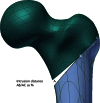Does bone compaction around the helical blade of a proximal femoral nail anti-rotation (PFNA) decrease the risk of cut-out?: A subject-specific computational study
- PMID: 23673407
- PMCID: PMC3670539
- DOI: 10.1302/2046-3758.25.2000150
Does bone compaction around the helical blade of a proximal femoral nail anti-rotation (PFNA) decrease the risk of cut-out?: A subject-specific computational study
Abstract
Objectives: Because of the contradictory body of evidence related to the potential benefits of helical blades in trochanteric fracture fixation, we studied the effect of bone compaction resulting from the insertion of a proximal femoral nail anti-rotation (PFNA).
Methods: We developed a subject-specific computational model of a trochanteric fracture (31-A2 in the AO classification) with lack of medial support and varied the bone density to account for variability in bone properties among hip fracture patients.
Results: We show that for a bone density corresponding to 100% of the bone density of the cadaveric femur, there does not seem to be any advantage in using a PFNA with respect to the risk of blade cut-out. On the other hand, in a more osteoporotic femoral head characterised by a density corresponding to 75% of the initial bone density, local bone compaction around the helical blade provides additional bone purchase, thereby decreasing the risk of cut-out, as quantified by the volume of bone susceptible to yielding.
Conclusions: Our findings indicate benefits of using a PFNA over an intramedullary nail with a conventional lag screw and suggest that any clinical trial reporting surgical outcomes regarding the use of helical blades should include a measure of the femoral head bone density as a covariable.
Keywords: Cadaveric bone; Cut-out; Finite element analysis; Osteosynthesis; PFNA; Trochanteric fracture.
Conflict of interest statement
Figures



Similar articles
-
[Comparison of 2-Screw Implant and Antirotational Blade Implant in Treatment of Trochanteric Fractures].Acta Chir Orthop Traumatol Cech. 2020;87(4):268-272. Acta Chir Orthop Traumatol Cech. 2020. PMID: 32940222 Slovak.
-
Acetabular perforation after medial migration of the helical blade through the femoral head after treatment of an unstable trochanteric fracture with proximal femoral nail antirotation (PFNA): a case report.J Orthop Trauma. 2011 Sep;25(9):e86-9. doi: 10.1097/BOT.0b013e3181fae12e. J Orthop Trauma. 2011. PMID: 21577153
-
TFNA Implant Failure with Helical Blade Cut-out.J Orthop Case Rep. 2020 Dec;10(9):61-64. doi: 10.13107/jocr.2020.v10.i09.1904. J Orthop Case Rep. 2020. PMID: 34169019 Free PMC article.
-
Gamma 3 U-Blade lag screws in patients with trochanteric femur fractures: are rotation control lag screws better than others?J Orthop Surg Res. 2019 Dec 16;14(1):440. doi: 10.1186/s13018-019-1427-z. J Orthop Surg Res. 2019. PMID: 31842911 Free PMC article.
-
[Comparative study of proximal femoral shortening after the third generation of Gamma nail versus proximal femoral nail anti-rotation in treatment of intertrochanteric fracture].Zhongguo Xiu Fu Chong Jian Wai Ke Za Zhi. 2018 Mar 15;32(3):338-345. doi: 10.7507/1002-1892.201710065. Zhongguo Xiu Fu Chong Jian Wai Ke Za Zhi. 2018. PMID: 29806285 Free PMC article. Chinese.
Cited by
-
Impact of Anterior Malposition and Bone Cement Augmentation on the Fixation Strength of Cephalic Intramedullary Nail Head Elements.Medicina (Kaunas). 2022 Nov 13;58(11):1636. doi: 10.3390/medicina58111636. Medicina (Kaunas). 2022. PMID: 36422175 Free PMC article.
-
Favorable revision-free survivorship of cemented arthroplasty following failed proximal femoral nail antirotation: a case series with a median follow-up of 10 years.BMC Musculoskelet Disord. 2022 Nov 29;23(1):1024. doi: 10.1186/s12891-022-05995-2. BMC Musculoskelet Disord. 2022. PMID: 36443844 Free PMC article.
-
Comparison of Helical Blade Systems for Osteoporotic Intertrochanteric Fractures Using Biomechanical Analysis and Clinical Assessments.Medicina (Kaunas). 2022 Nov 22;58(12):1699. doi: 10.3390/medicina58121699. Medicina (Kaunas). 2022. PMID: 36556901 Free PMC article.
-
A quantitative biomechanical study of positive buttress techniques for femoral neck fractures: a finite element analysis.Chin Med J (Engl). 2019 Nov 5;132(21):2588-2593. doi: 10.1097/CM9.0000000000000490. Chin Med J (Engl). 2019. PMID: 31658158 Free PMC article.
-
Mechanical analysis of modified femoral neck system in the treatment of osteoporotic femoral neck fractures.BMC Musculoskelet Disord. 2024 Oct 4;25(1):789. doi: 10.1186/s12891-024-07907-y. BMC Musculoskelet Disord. 2024. PMID: 39367368 Free PMC article.
References
-
- Lorich DG, Geller DS, Nielson JH. Osteoporotic pertrochanteric hip fractures: management and current controversies. Instr Course Lect 2004;53:441–454 - PubMed
-
- Windolf M, Muths R, Braunstein V, et al. Quantification of cancellous bone-compaction due to DHS Blade insertion and influence upon cut-out resistance. Clin Biomech (Bristol, Avon) 2009;24:53–58 - PubMed
-
- O’Neill F, Condon F, McGloughlin T, et al. Dynamic hip screw versus DHS blade: a biomechanical comparison of the fixation achieved by each implant in bone. J Bone Joint Surg [Br] 2011;93-B:616–621 - PubMed
-
- Wähnert D, Gudushauri P, Schiuma D, Richards G, Windolf M. Does cancellous bone compaction due to insertion of a blade implant influence the cut-out resistance?: a biomechanical study. Clin Biomech (Bristol, Avon) 2010;25:1053–1057 - PubMed
-
- Born CT, Karich B, Bauer C, von Oldenburg G, Augat P. Hip screw migration testing: first results for hip screws and helical blades utilizing a new oscillating test method. J Orthop Res 2011;29:760–766 - PubMed
LinkOut - more resources
Full Text Sources
Other Literature Sources

